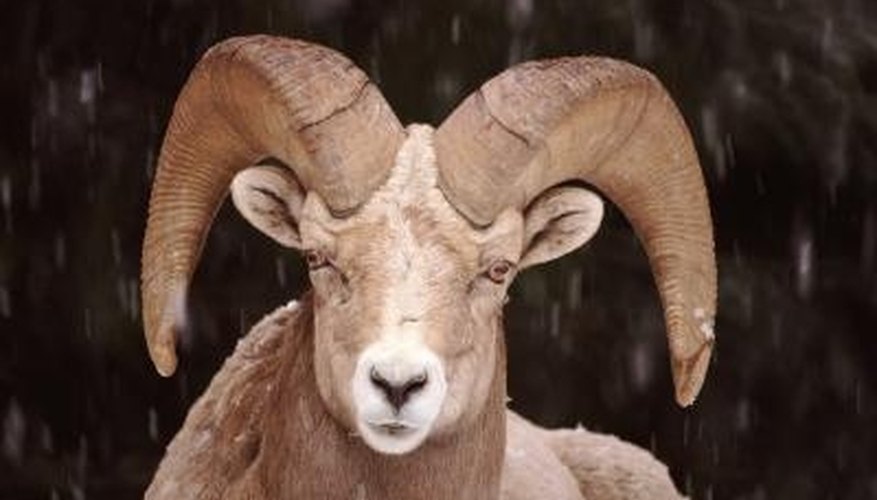
Hunters in North America pursue four species of big game sheep: the Dall, Stone, Big Horn and Desert sheep, which all make impressive head mounts. The first step to a good mount is to cape the animal properly. Caping involves the careful skinning of the animal's head, beginning with the hide just behind the shoulders. Guides take most sheep on hunts where the guide takes proper care of the animal; however, a hunter without a guide needs to learn before the hunt how to cape the sheep he will take.
Items you will need
Hunting knife, 4 inch blade
Cut through the hide completely around the girth of the sheep directly behind the front legs. Cut through the hide around the upper muscle of each front leg. Make a cut from the girth cut on the bottom chest to the cut around the legs on the inside of each leg.
Poke the knife tip under the hide at the girth cut on the backbone. Make a cut straight up the backbone to a point 6 inches below the back of the horns. Make a cut from the end of this cut to the back of each horn, forming a Y.
Run the knife blade around the base of each horn where the hide meets the horn. Cut completely through the hide until you can see the thin layer of flesh against the bone.
Pull the hide up and away from the neck at the backbone cut. Cut through the membrane that holds the hide to the carcass to free the hide from the neck. Continue to pull out the hide and cut it free all around the shoulders and neck until you reach the skull.
Cut through the ear cartilage against the skull, leaving the large end of the cartilage on the ear. Do this to both ears. Cut through the membrane between the hide and skull to free the skin up to the horns.
Push the knife tip under the hide between and around each horn. Use the knife to cut and pry the skin up and loose. The hide is thin here, so keep the blade angled against the skull while cutting.
Pull the hide away from the skull, skinning it free down to the eyes. Push your finger through the eye hole from the outside and lift the hide while cutting through the membrane covering the eye and freeing the eyelids and the skin around the eye. Dig the knife tip into the flesh in front of the eye all the way to the bone and cut out the tear duct pocket intact.
Pull the hide down and cut between the hide and skull to skin the hide from the muzzle down to the mouth. Hook your finger through the corner of the mouth and stretch the hide away from the jaws. Cut directly against the upper and lower jaw bone to free the lips and mouth from the skull.
Cut straight down through the nose cartilage where it meets the muzzle portion of the skull bone. The cape is now free of the skull. Saw through the eye sockets to remove the horns, keeping them attached to the skull plate. Keep them with the cape.
Warnings
- Angle the knife blade against the skull while skinning the head to prevent cutting holes in the thin skin.
- Keep the knife sharp; sharpen it whenever it grows dull. A dull knife causes you to push harder which increases the chances of cutting the hide. A sharp knife slides through the membrane quickly without undue pressure put on the blade.
Tips
- The finished mount will only go to the front of the shoulders, but by keeping the extra hide behind the shoulders on the cape, it gives the taxidermist more to work with. The hide will be tacked down on the backside of the head form. It is better for the taxidermist to have too much hide than too little.
- Do not cut the eye holes larger than their normal size. Free the hide so as not to cut through the eye rim skin and eyelids. The whole tear duct needs to come out or the face will have a hole in front of the eye.
- Skin carefully around the mouth, making sure the lips are intact on the hide. Do not cut the lips off, leaving them on the skull.
References
- "Outdoor Life Complete Home Taxidermy;" Tim Kelly; 1987
Tips
- The finished mount will only go to the front of the shoulders, but by keeping the extra hide behind the shoulders on the cape, it gives the taxidermist more to work with. The hide will be tacked down on the backside of the head form. It is better for the taxidermist to have too much hide than too little.
- Do not cut the eye holes larger than their normal size. Free the hide so as not to cut through the eye rim skin and eyelids. The whole tear duct needs to come out or the face will have a hole in front of the eye.
- Skin carefully around the mouth, making sure the lips are intact on the hide. Do not cut the lips off, leaving them on the skull.
Warnings
- Angle the knife blade against the skull while skinning the head to prevent cutting holes in the thin skin.
- Keep the knife sharp; sharpen it whenever it grows dull. A dull knife causes you to push harder which increases the chances of cutting the hide. A sharp knife slides through the membrane quickly without undue pressure put on the blade.
Writer Bio
Dave P. Fisher is an internationally published and award-winning Western novelist and short-story writer. His work has appeared in several anthologies and his nonfiction articles in outdoor magazines. An avid outdoorsman, Fisher has more than 40 years of experience as a hunter, trapper, fisherman, taxidermist, professional fly-tyer, horsepacker and guide.



